Laboratory Syringe Pumps
Pump Modules for Continuous Flow Chemistry
Flow chemistry is all about controlling our reaction conditions. If we can do this with precision we can harness the benefits of flow chemistry experiments. When we perform a flow experiment practically, we want to do the following:
- Control addition and mixing
- Control stoichiometric equivalents
- Control reaction times
- Control reaction temperatures
When designing a flow chemistry process, it is difficult to know where to begin to select the right equipment for your laboratory. There are two essential pieces of the equation that hold equal importance to reaction control: the pump and the reactor.
Most people would immediately think of the flow reactor to be the most important, but choosing the right syringe pump system is equally important. The pump covers three of the four examples above so it’s a significant part of the equation.
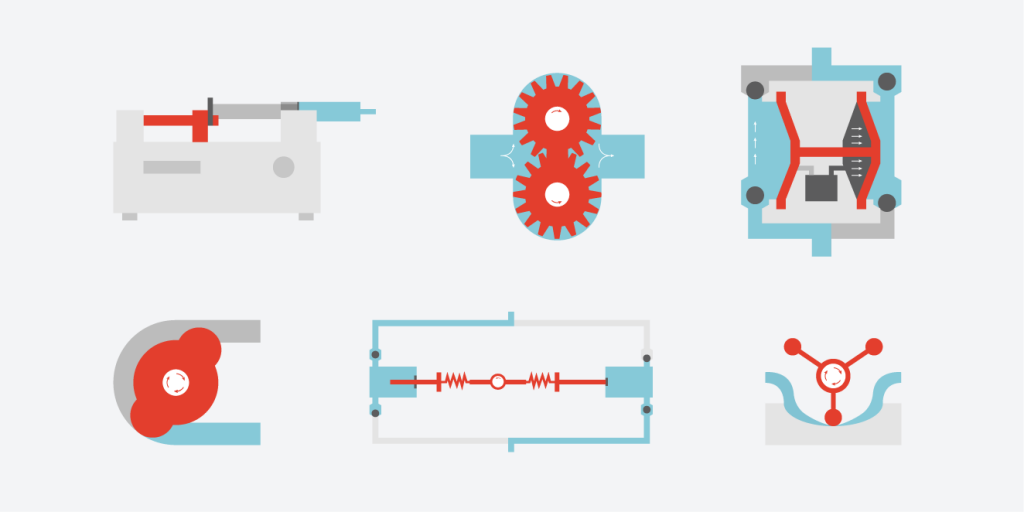
What does the pump add to my experiment?
The syringe pump covers three of the four examples above so it’s a significant part of the equation.
- We start with solutions of our reactants of a known concentration.
- The solutions are introduced into the fluidic pathway either directly through the pump or via a reagent injector (if we’re introducing smaller amounts).
- If the flow rate of the pump in known we can precisely control the stoichiometry (molar ratio of reactants) of our reaction.
- We know the flow reactor volume so we can also control the length of time our reactants spend in the reactor environment.
A common mistake by is to think that any pump can be used in flow. Selecting the best pump for your application is a key factor.
What kind of pump can I use?
There are several pumping regimes that can be used for a flow chemistry experiment; each has advantages and disadvantages for certain applications.
What are you going to be pumping?
- Are your reagents/solvents corrosive?
- Are they viscous and difficult to pump or
- Do they have low boiling points?
- Are your reagents a slurry or suspension?
What flow rate ranges do you require?
-
- Certain pumps are better at delivering either lower or higher flow rates.
How important is accuracy?
-
- Accuracy is key, some pumps are more accurate than others.
- Some pumps have a higher level of pulsation which gives rise to flow rate variation.
Do you require automation or have safety considerations?
-
- Most pumps can be controlled remotely and integrated into software control.
- Do you require pressure monitoring?
For a pump to have the most impact in a flow chemistry experiment, it must be chemically resistant, have a precise and accurate flow over a wide range of flow rates and have minimal pulsation. Pressure monitoring allows us to see any issues due to precipitation or blocking of our reactor.
Syringe Pumps
What is a Syringe Pump?
Syringe pumps, or syringe drivers, are devices that accurately control the delivery of a fluid from a syringe typically by automation of the plunger.
The syringe is held in place and the plunger, attached to a stepper motor is accurately moved to deliver the solution. The accuracy and speed of the stepper motor and the volume of the syringe determines the flow rate and precision of the delivery.
There are many applications and uses for syringe pumps, both in scientific laboratories and by healthcare professionals. Medical syringe pumps (or infusion pumps) deliver medication to a patient via a syringe rather than an intravenous bag. The advantage of a medical programmable syringe pump over the manual use of a syringe is that they can administer a drug at a steady rate over a long period of time with defined flow rates for patient safety. We use syringes pumps in the laboratory for the same reason.
In a typical research laboratory, syringe pumps enables a wide range of chemical processes to deliver or withdrawal a precise amount of material into a batch reaction for dosing or sampling, or to add a continuous stream of reactant for flow chemistry.
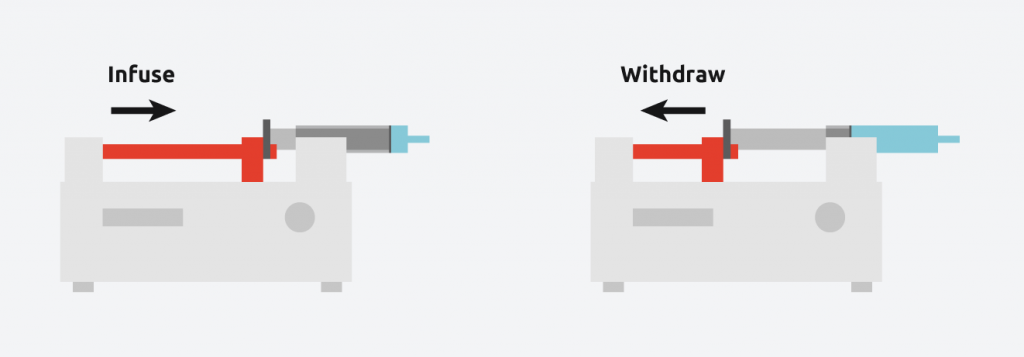
Single vs Dual Syringe Pumps
Single Syringe Pumps
Most people will be familiar with “single-shot” syringe pumps – these are commonplace in the laboratory. These are used to dispense a fixed volume, depending on the syringe volume. The single-shot syringes are good for delivering an accurate volume but for flow chemistry, they are limited as the amount they deliver is restricted to the fixed syringe volume.
Dual Syringe Pumps
Dual syringe pumps allow you to control either one or both syringes. When combined with solvent/reagent reservoirs and check valves, dual syringes can provide a continuous flow that is not restricted to the syringe volume. When applied to flow chemistry these reciprocating syringes allow for a continuous flow of material into the reaction. One syringe fills with the reagent/solvent while the other one is dispensing the fluid to the reactor.
Syrris offer a dule syringe pumping solution in the form of the Asia Syringe Pump.
Benefits of syringe pumps:
- High precision and accuracy at both high and low flow rates
- High chemical compatibility
- Most suitable for low boiling point and vapor pressure solvents
- Pulse free flow for single syringe devices
- Can withdraw and dispense for sampling and delivery.
- No calibration required.
Disadvantages of syringe pumps
- “Single-shot” syringe pumps limited to pumping finite volumes (i.e syringe volume)
- Limited ability to pump solids – suspended solids, slurries etc
- Single shot syringe pumps typically operate at lower pressures whilst the Asia Syringe dual pump can work up to 20bar pressure making it extremely versatile.
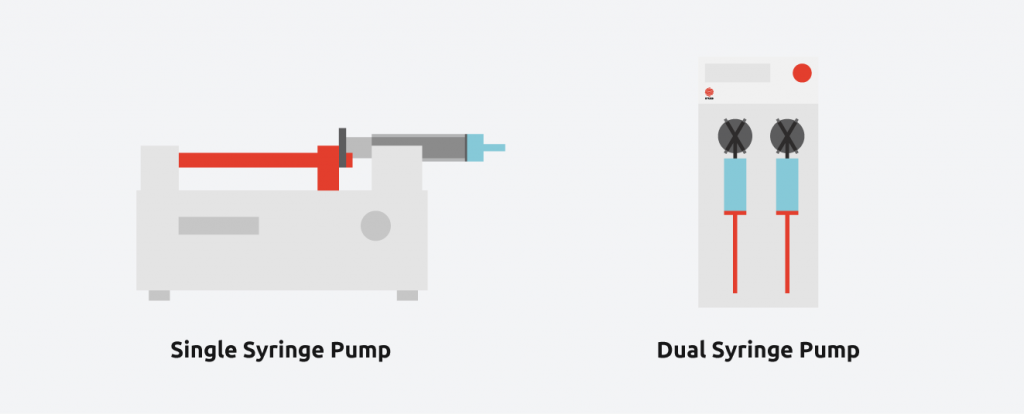
HPLC-type pumps
HPLC type pumps can be used in flow chemistry applications. HPLC pumps are typically dual-piston pumps, although single reciprocating piston pumps can be used. The two pistons are out of phase, like continuous syringe pumps; while one pump head fills, the other delivers.
The material of construction can be 316 stainless steel, titanium, Hastelloy C or ceramic. Stainless steel pumps are most common and can have chemical compatibility issues, so you need to be careful with the construction material.
Benefits of HPLC pumps
- Can pump at high flow rates and pressures. UPLC systems typically operate at >8000psi (>552 bar).
Disadvantages of HPLC pumps
- Limited with lower flow rates <200µl/min restricting longer residence times with microreactors and molar ratio accuracy.
- Can create pulsation, causing disruption of mixing and ratio of reagents, affecting reaction quality at low flow rates
- Not suitable for use with low boiling point, low vapour pressure solvents due to solvent cavitation.
- Require priming of reagents/solvents, not ideal if a hazardous solution is being pumped.
- Requires calibration
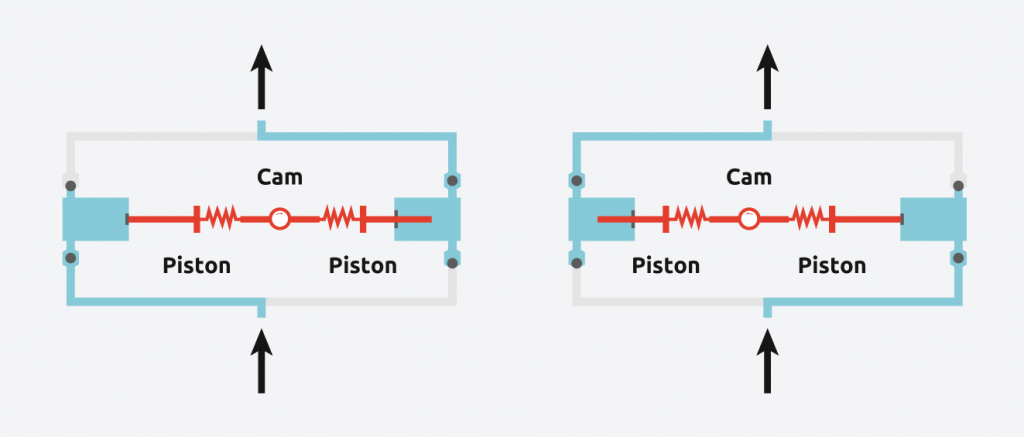
Peristaltic Pumps
Peristaltic pumps are used in a variety of applications and are gaining some use in flow chemistry. Peristaltic pumps dispense fluid using a rotating roller mechanism to create alternating compression and relaxation of a flexible tube., drawing in contents from an external reservoir and dispensing to a suitable reactor, a flow reactor in this case.
Their main use in flow chemistry is that of pumping light slurries and suspensions.
Benefits of Peristaltic pumps
- Pumping light slurries and suspensions and viscous material
- Low maintenance, no requirement for valves, seals etc.
- Pumping IV fluids through an infusion device in healthcare to deliver medication
Disadvantages of Peristaltic pumps
- Limited with lower flow rates <200µl/min restricting longer residence times with microreactors and molar ratio accuracy.
- Can create high pulsation, causing disruption of mixing and ratio of reagents, affecting reaction quality at low flow rates
- Typically have poor chemical compatibility unless expensive tubing is used.
- Tubing degrades quickly due to mechanical wear.
- Requires calibration.

Gear Pump
Gear pumps use the meshing of gears within a sealed case to pump fluid, providing a pulse-free flow proportional to the rotational speed of the gears. As the gears rotate and the meshed teeth separate, a partial vacuum is formed which fills with fluid. As the gears continue to rotate, they trap the liquid and move it around the casing from the suction point to the discharge point.
Benefits of Gear pumps
- Compact and simple with limited number of moving parts
- High pressure and flow rates (when combined with amass flow controller)
- Can handle high viscosity liquids (Internal gear pumps up to 1,000,000cp)
- Wide operating temperature (internal gear pumps only)
- Relatively cheap and replaceable in a manufacturing environment.
Disadvantages of Gear pumps
- Must be operated near to maximum rated speed to maintain performance
- Susceptible to wear when used with abrasive fluids
- Require mass flow controller to control flow rates.
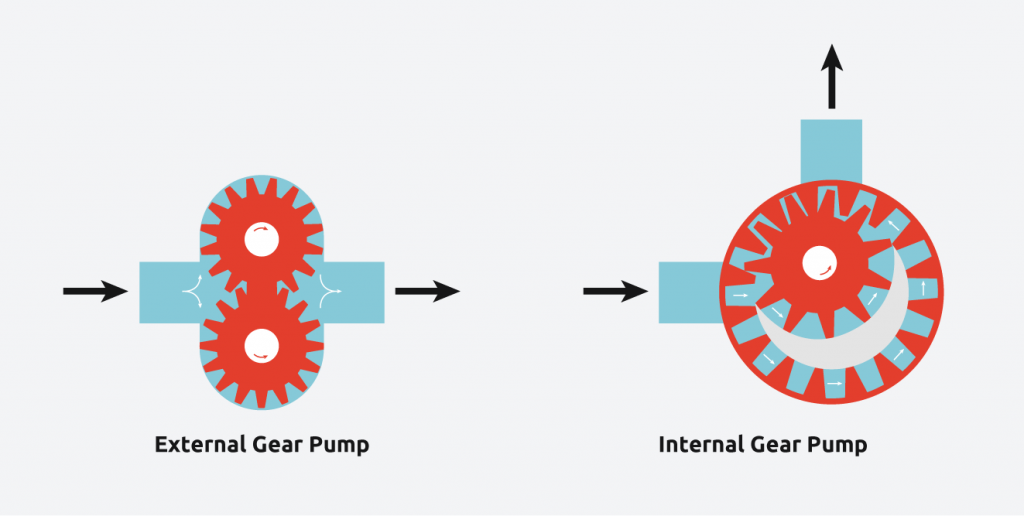
Pumping slurries and suspensions
Pumping slurries and suspensions in smaller diameter tubing is not the best practice when running a lab scale flow reaction. Just because you can, doesn’t mean you should. At some point fowling may occur and if we need to heat the reaction under pressure this adds an extra issue with the flow restrictions of a back pressure regulator. If the suspension is stable and the solid doesn’t aggregate (or need constant agitation), then this is less of a problem. Pumping slurries does become easier as the geometry of the reactor increases, methods such as Oscillatory Baffled Reactors (OBRs) or Continuously Stirred Tank Reactors (CSTRs) are the preferred method here.
Discover Syrris Syringe Pumps for Batch and Flow Systems
Whether you want to use your pump for batch or flow applications Syrris offers world class syringe pumps for your laboratory.
The Asia Syringe Pump has been designed specifically for flow chemistry the Asia Syringe provides an ultra-smooth flow rate of 1.0 μL/min to 10 mL/min and pressures up to 20 bar (300psi), and high chemical compatibility.
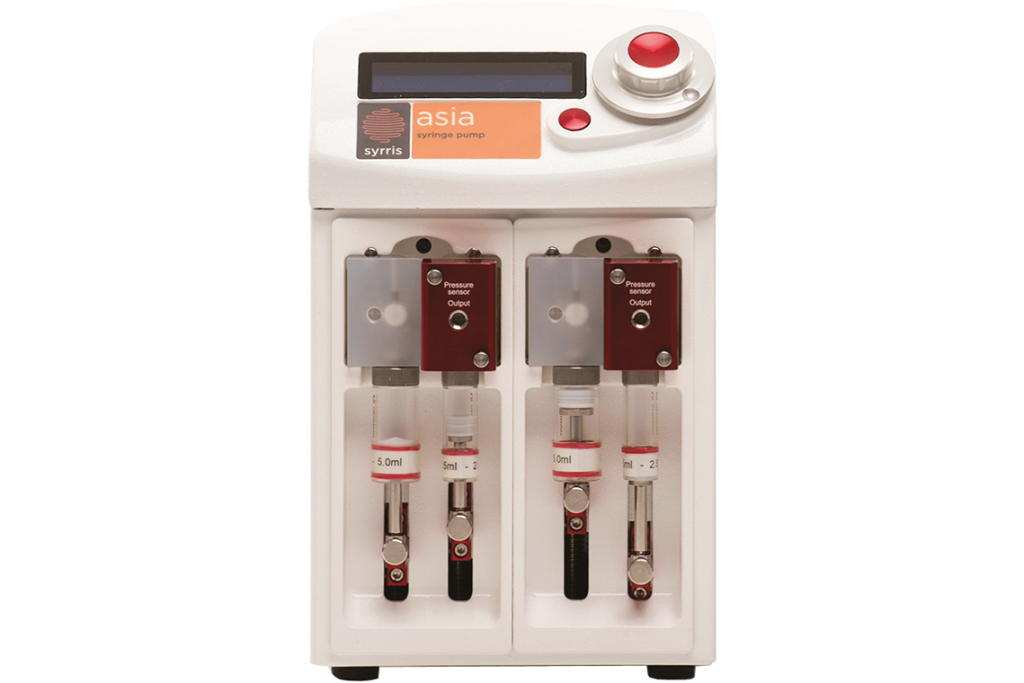
The Atlas Syringe Pump and Atlas XL Syringe Pumps are a perfect addition to your lab, and can be used as standalone syringe pumps with your existing batch reactors or controlled by the Atlas HD automated reactor or the Atlas PC Software. Offering a small footprint, Atlas Syringe Pumps are lightweight enough to be easily moved between lab benches.
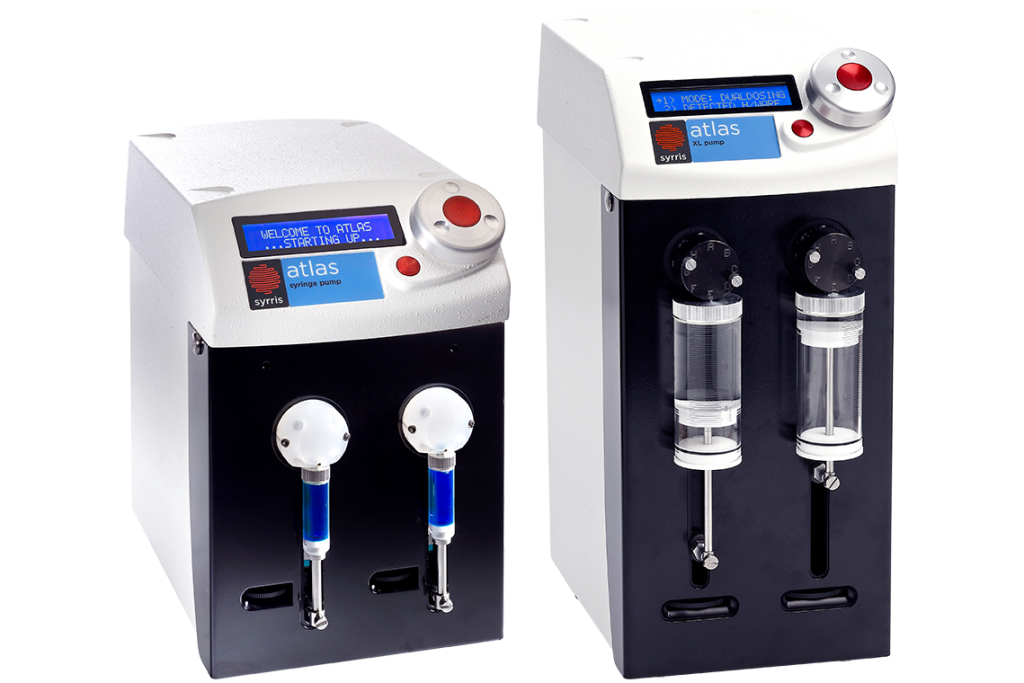
Contact our team of specialists to find out how Syrris Syringe Pumps could help your batch or flow chemistry applications.